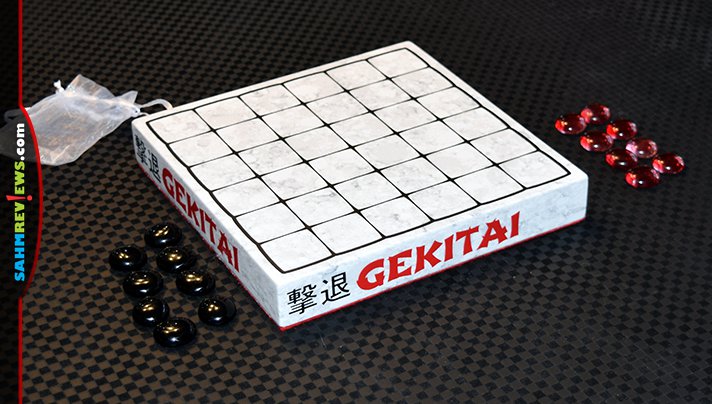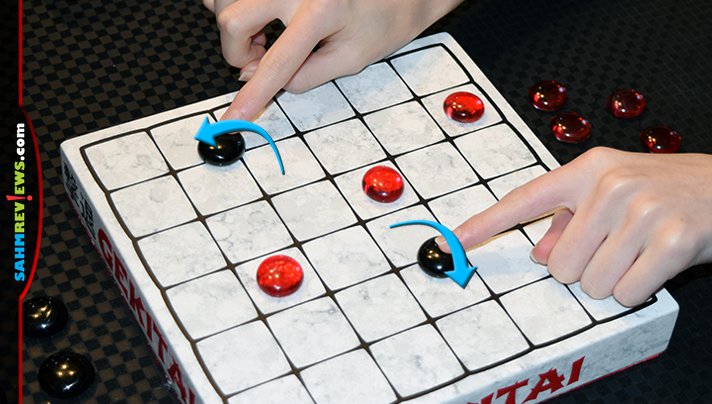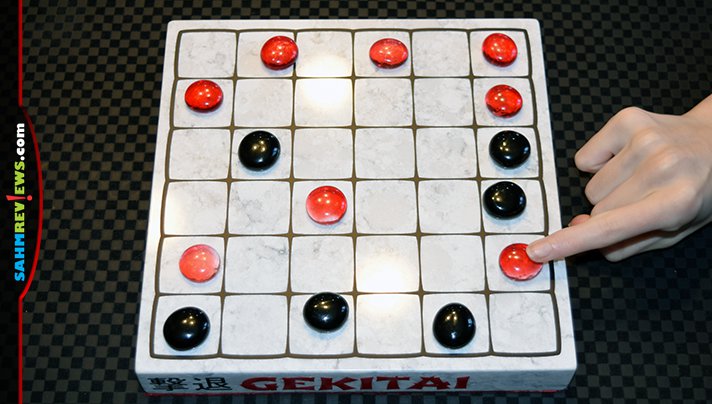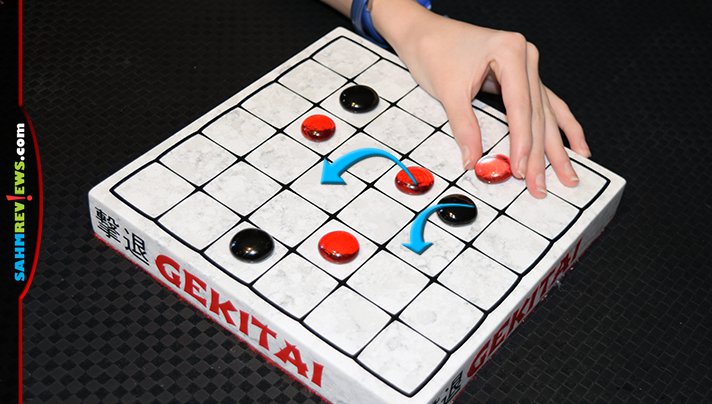Gekitai Abstract Strategy Game Overview

By now you know that we like to start with an introduction when we write about anything. Sometimes we are reminiscing about some memory jarred by a game. Other times we talk about similar products. This time, I’m going to reserve those comments for the end – with good reason. It will make more sense when we get to that point. Right now, however, I want to jump right in and tell you about Gekitai. Why? Because I’m really excited about it!
Gekitai is a 2-person abstract strategy game. Setup is pretty simple… find an opponent and set the board between you. Each player takes one of the sets of eight markers, a starting player is selected and you’re ready to go! The object of the game is to have three of your own pieces in a row or have all eight of your markers on the board at the end of your turn. Before you start comparing it to tic-tac-toe, checkers or some other game on a grid, keep reading. It is NOT as easy as you think. It’s elegant in design and chaotic in action. Gekitai will have you shaking your head when you inevitably give your opponent the win. Yes, it will happen. Thankfully, you can start and finish a thought-provoking session in about five minutes.
To begin the game, the starting player places one of their markers on any space on the board. The second player does the same. But here’s the catch. When you place a marker on the board, it repels everything in the spaces immediately surrounding it. That’s actually the origin of the game’s name. Gekitai is the Japanese translation of repel or push away.
As I said, everything around a recently placed marker is impacted. Whether it’s yours or your opponent’s piece, it will move one space away in the opposite direction of the piece that was just added to the board. If the piece you’re nudging is on the edge of the board, it falls off and is returned to the owner. Pieces aren’t captured in Gekitai.
So at this point, you may be asking yourself how you can possibly win if you’re always pushing pieces away from each other. There are three answers to that question. First, as I mentioned before, one of the ways to win is to have all eight of your markers on the board at the end of your turn. As you’re in the midst of trying to play your moves and avoid letting your opponent win, you may find yourself forgetting to count how many pieces your opponent has on the board. Every time that I’ve lost this way it’s because I was too focused on playing to notice!
But that doesn’t really answer how you can get three in a row, does it? The marker being placed doesn’t have to be one of the three. So if you’re able to push another marker into position, that can cause a win. I call this the triangle effect because when there are three pieces in a triangle on the board, you need to watch for this!
The third answer is that there is an exception that will prevent a piece from being pushed. If there are two markers lined up next to each other and a third is placed alongside it, there isn’t room for the adjoining piece to move. While all other pieces will move as normal, blocked pieces, even if they are opposing colors, don’t budge.
After you have repelled all the necessary pieces, check if the win condition of three like pieces in a row has been met or eight of one person’s pieces are on the board. If so, the person with the three aligned pieces is declared the winner. That may be you… or you may have inadvertently pushed an opponent’s piece in for the win!
We’ve played Gekitai more times that I can count, often with the winner undoing the last move to jump start the game from where it left off before the error that caused the win. Gekitai is a 2-person game, but often draws an audience of “Ooh. I see a move!” onlookers. Hobby gamers have played and enjoyed it. We’ve introduced it to non-gamers who have said, “I would buy this and leave it on my table.” Recently, an elementary-aged neighbor gave it a shot and did quite well. Like any abstract strategy game, it’s not age-restrictive. Someone young is capable of playing if the rules are explained. It’s about learning how to play and giving it a shot. Here’s the point where I usually tell you how much it costs or where to buy it, but this is even better. Gekitai is available as a print and play. You can use your own markers (nickels and pennies work great), download a copy of the board and the Gekitai instructions FOR FREE and give the game a try for yourself!
At the beginning of the article, I said I would explain why I’m so incredibly excited about the game. Aside from the fact that Gekitai is a lot of fun, free to download and only takes about five minutes, I’m married to the designer. Scott has been working hard to perfect Gekitai for several months and we’re thrilled with the final result. As you can see from the pictures, we have physical copies and may be selling those on Etsy. If you’re interested in purchasing a hand-made copy of Gekitai, shoot us an email or leave a comment and we’ll be happy to give you a quote for one. Stay tuned for details coming out of New York Toy Fair about another game that Scott designed!
How often to you print your own versions of games?












Gekitai looks great! Thanks for the write-up.
Thanks, Ed. Let us know if you download it and what you think!
i would give it a try
We read your review and immediately drew up a board and tried a few games. We haven’t played nearly enough to formulate a strategy as yet, but the game mechanic of having a piece repel adjacent pieces makes for an interesting game. The simple game components means that you can set up and play almost anywhere using almost anything! This is a game that will make it to our gaming table again and again.
Thank you for such a thoughtful response, Robert. I’m glad to hear you’re enjoying it! I personally enjoy how quick it is. So many abstract games are long and dry. I’m happy playing this one multiple times in a row.
i dont see why it couldnt be done pnp as you say
This sounds interesting!
I wish I could play a game like Gekitai Abstract Strategy! I would have to buy a new sharp brain, because my own can’t wrap around any of these Abstract Strategy Games anymore! It’s hell to get old and to lose your memory. I would otherwise, love to play this!
Oh, Sue. I hear you on getting old and losing your memory. Thankfully, this one is quick and you don’t have to remember things. 🙂 You should print it out and give it a try since it doesn’t cost anything. I struggle with abstract games also, but the simplicity of Gekitai makes it approachable. When we play, we’ll often let the losing player take back their last move to give them an opportunity to rethink their action and continue the game.
I would be interested in buying a Gekitai game set if you still have any available.
Hi Craig! Right now I only have hand-made prototypes and a few nicer ones that are made from wood & tile. I am considering self-publishing if a publisher doesn’t pick it up for their line. You can see them for sale on BGG – https://boardgamegeek.com/boardgame/295449/gekitai/marketplace/geekmarket
This looks pretty cool
Looks like a fun game. I generally don’t do pnp, mainly because I don’t have a printer, but this one looks fun.
Looks interesting and would at some time maybe print out my own copy.
I’m not much for print and play games since they get ruined so easily but this seems like it would be fine.
glue the board onto some foam core or cardboard
I think printing out your own copy of Gekitai to play is a good way to try out the game.
That sounds interesting, good way to try the game
The game sounds fun and I would not be opposed to printing out my own strategic board on my printer.
I came up with a silly but fun position.
Assuming the bottom left corner is A1, place red pieces at A1, A3, A5, B4, D4, E3 and E5. Place black pieces at B2, B6, C3, C5, D2, D6 and F6.
Now if whoever plays next puts their last piece at C4, they win by having all 8 men on the board, create two 3-in-a-rows for themselves as well as two 3-in-a-rows for their opponent! 🙂
thinking of it as a number grid like chess will help with stratagy
That would be an interesting situation! I’ve toyed with the idea of making it into a puzzle game where something like this is laid out and the challenge is to place one piece to win. Your example fits right into it!
1 question where did you get the large cabochons you used as tokens
i could see this being popular for D&D games as an in-world game since it’s simple but has a lot of strategy
The glass cabs are from Michael’s Craft Store. They have a number of different colors and sizes, and with their discount coupons they are pretty affordable. You can also find them on Amazon by searching for “fire beads”, since they’re also used in fire pits!
Hello,
Seems to be a very good game.
May I do an implementation for Second Life Metaverse ?
Take Care
Thanks for asking. I’d ask you to hold off until I speak with the publisher. It’ll be released in September under the new name, Boop. ! Let me see how they feel about it since they now have publishing rights.